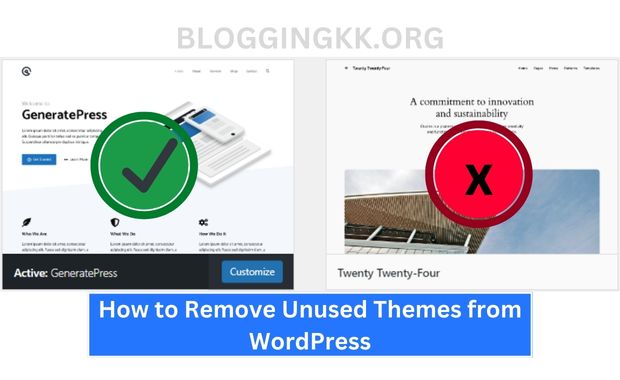Unused themes in WordPress can take up valuable space, pose potential security risks, and clutter your admin dashboard. Regularly cleaning up your site by removing these unused themes is a best practice for maintaining an optimized and secure WordPress environment. This comprehensive guide walks you through the steps to safely remove unused themes, ensuring your website remains clean, secure, and efficient.

Why Remove Unused WordPress Themes?
1. Enhanced Security
Unused themes that are not updated regularly can become a vulnerability for hackers.
2. Optimized Performance
While inactive themes don’t directly slow down your site, removing them can free up server resources.
3. Easier Management
A clutter-free WordPress dashboard improves overall manageability.
4. Reduced Storage Usage
Each theme occupies space on your server. Removing unused themes frees up this space.
Step-by-Step Guide to Remove Unused Themes
1. Identify Unused Themes
First, determine which themes are unused. WordPress allows only one active theme at a time; others remain inactive. How to Install Hestia Theme.
| Theme Status | Action Needed |
|---|---|
| Active Theme | Keep |
| Inactive Themes | Consider Removing |
To view your themes:
- Log in to your WordPress admin panel.
- Navigate to
Appearance > Themes. - Identify inactive themes (those not labeled “Active”).
2. Backup Your Website
Before making any changes, create a full backup of your website. This ensures you can restore your site if anything goes wrong.
How to Backup WordPress:
- Using a Plugin: Plugins like UpdraftPlus or BackupBuddy make backups simple.
- Manual Backup: Use cPanel or an FTP client to download your site’s files and database.
3. Delete Unused Themes via WordPress Dashboard
The easiest way to remove themes is through the WordPress dashboard. How to Install Soledad Theme.
Steps:
- Go to
Appearance > Themes. - Click on the theme you want to delete.
- In the bottom-right corner of the pop-up window, click “Delete.”
- Confirm the deletion.
| Pros | Cons |
| Simple and user-friendly | May not remove all files |
| No external tools required |
4. Delete Unused Themes via FTP or File Manager
For advanced users, FTP or File Manager offers a more comprehensive approach to removing themes. How to Install Foodica Theme.
Steps:
- Access your site’s files using an FTP client (e.g., FileZilla) or your hosting provider’s File Manager.
- Navigate to
wp-content/themes/. - Locate the folder of the theme you want to delete.
- Right-click and select “Delete.”
| Pros | Cons |
| Complete removal of files | Requires basic technical skills |
| Useful for troubleshooting | Risk of accidental deletion |
5. Use WP-CLI to Remove Themes
If you’re comfortable with command-line tools, WP-CLI provides a fast and efficient way to manage themes. How to Install Neve Theme.
Steps:
- Open your terminal or SSH client.
- Navigate to your WordPress directory.
- Run the command:
wp theme delete <theme-slug>Replace<theme-slug>with the folder name of the theme.
| Pros | Cons |
| Extremely fast and efficient | Requires WP-CLI setup |
| Ideal for developers | Not beginner-friendly |
How to Ensure Safe Theme Removal
1. Check Dependencies
Some themes may have dependencies, such as plugins or child themes. Verify that removing the theme won’t break your site.
2. Test Your Website
After removing a theme, test your site to ensure it functions as expected. Use tools like:
- Browser Testing: Verify visual elements and functionality.
- Debugging Plugins: Identify and fix potential errors.
Frequently Asked Questions
1. Can I Reinstall a Deleted Theme?
Yes. You can always reinstall a deleted theme from the WordPress repository or by uploading its ZIP file.
2. What Happens to My Content?
Content like posts and pages remains intact, even if you delete a theme. However, theme-specific settings may be lost.
3. Should I Delete the Default Theme?
Keep at least one default theme (e.g., Twenty Twenty-One) as a fallback in case your active theme fails.
Tips for Maintaining a Clean WordPress Installation
- Regularly Review Installed Themes: Periodically check and remove themes you no longer need.
- Update Active Themes: Ensure your active theme is updated for security and performance.
- Monitor Site Performance: Use tools like GTmetrix or Google PageSpeed Insights to evaluate site speed.
- Secure Your Site: Use security plugins like Wordfence to protect against vulnerabilities.
Conclusion
Removing unused WordPress themes is a simple yet crucial task for maintaining a secure and efficient website. Whether you use the WordPress dashboard, FTP, or WP-CLI, the process ensures your site remains clutter-free and optimized. By following the steps outlined in this guide, you’ll create a streamlined WordPress environment that’s easier to manage and less vulnerable to threats. Regular maintenance goes a long way in ensuring the long-term success of your website. How to Install OceanWP Theme.